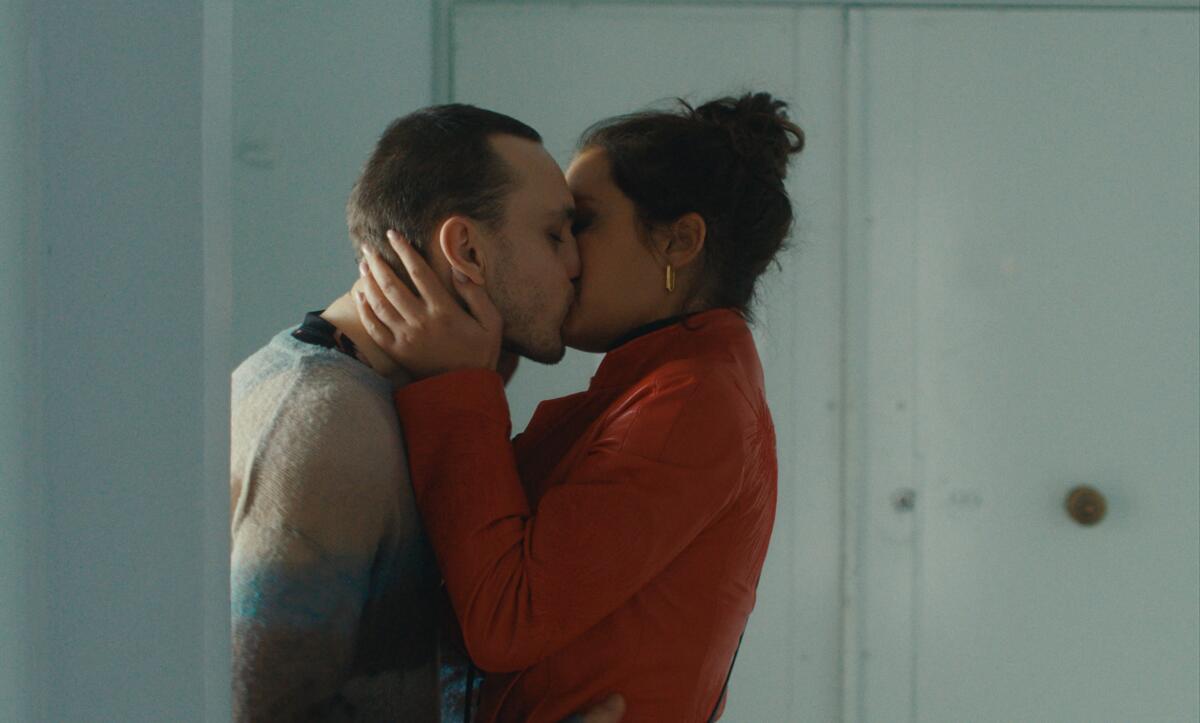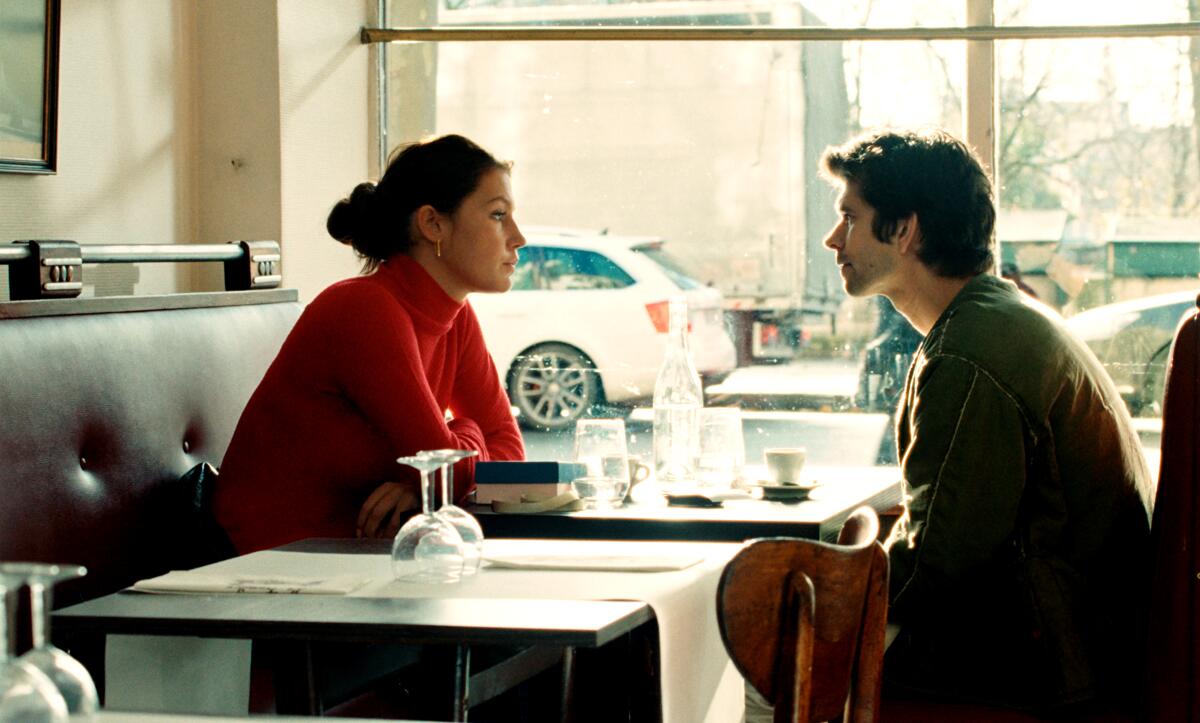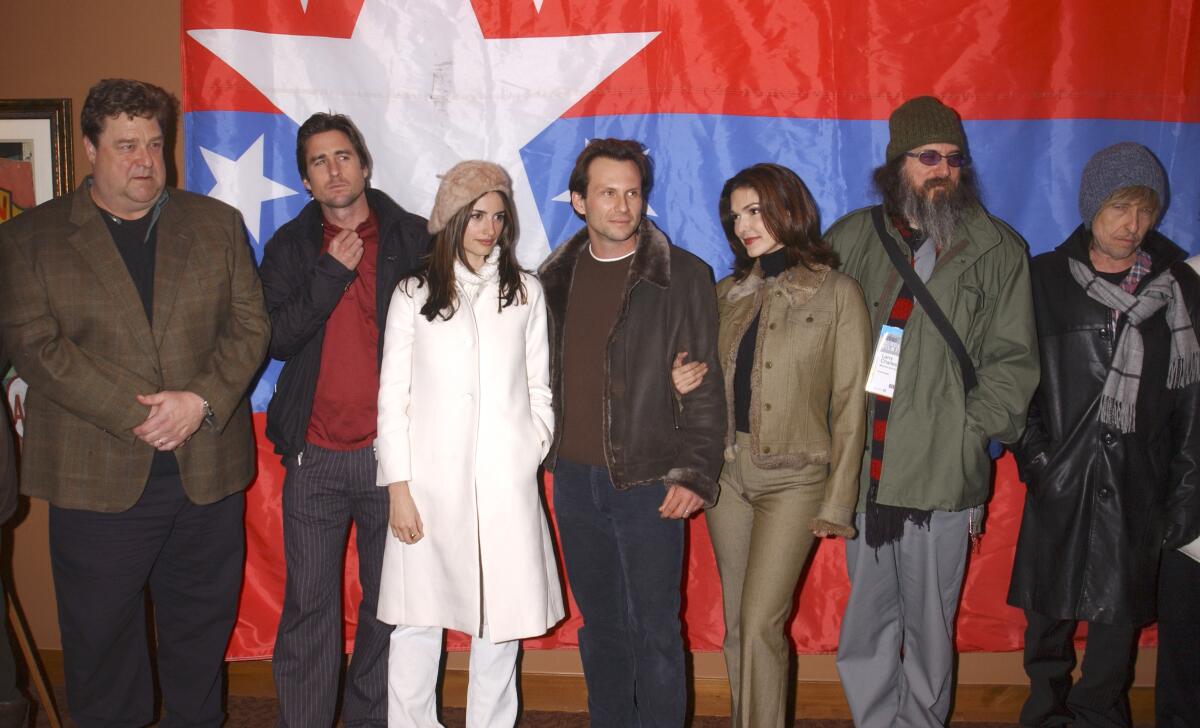The summer’s sexiest film, a Bob Dylan oddity and more to see in L.A. this week

Hello! I’m Mark Olsen. Welcome to another edition of your regular field guide to a world of Only Good Movies.
Earlier this week I took my own advice and went to see one of the films recommended here last week, the 70mm presentation of Luis Valdez’s “Zoot Suit” at the American Cinematheque’s Aero Theatre. And I’m so glad I did, as the movie is a genuinely unique and immersive hybrid of cinema and theater, and this was the ideal way to experience it.
Introducing the film, the Cinematheque’s chief projectionist, Ben Tucker, said he knew when he got to work that day, he would be showing a rare print of the film not publicly screened since 1981. What he did not know was that he would be introducing a surprise appearance by the film’s star, Edward James Olmos.
Olmos made a few remarks to introduce the film and also came back onstage for a warm and emotional post-screening Q&A with the audience. Without a moderator, Olmos reflected that he had not seen the film since its opening day in 1981 at the Cinerama Dome.
“I’ve never seen anything like this to this day,” Olmos said of the film and its unusual style. “Nobody would dare to do this.”
It was a magical evening, both for the surprise of the movie and the unexpected guest. You never know what can happen when you actually leave the house.
And here are the best things going on at the movies in L.A. over the next week.
‘Passages’ heats up the summer

Filmmaker Ira Sachs returns with some of his best work ever in “Passages,” a bracing exploration of desire and intimacy. In the film, a German filmmaker named Tomas living and working in Paris (Franz Rogowski) leaves his longtime partner Martin (Ben Whishaw) to begin an affair with Agathe (Adèle Exarchopoulos), one that has disastrous consequences for all three of them. Sachs will be appearing in L.A. for Q&As after select shows at the Nuart on Saturday and Sunday.
A sense of turned-on desire permeates the film like humidity, something in the air, and it is clearly the sexiest film of the summer, if not the year. While the film is not as explicit as it might be, there is a sex scene between Rogowski and Whishaw that certainly got audiences talking when the film premiered earlier this year at Sundance. I spoke to Sachs last month about the decision to reject an NC-17 rating and release the film unrated.
“There’s no untangling the film from what it is,” said Sachs. “It is a film that is very open about the place of sexual experience in our lives. And to shift that now would be to create a very different movie.”
In his review of the movie, Justin Chang wrote, “Sachs doesn’t give the sex any particular narrative emphasis; his matter-of-fact point is that this moment, and others like it, are as rich in dramatic significance and emotional complication as any of his characters’ experiences, and should be approached with the same frankness and curiosity. And if he acknowledges the undeniable, fiercely disruptive power of sex, he is also more than aware of its limitations. The final passages of ‘Passages’ feel at once sad and inevitable, suffused with a wisdom that, for Martin and Agathe, feels both hard-edged and hard-won. You suspect that Tomas may be in for a similar awakening, if he could ever bring himself to slow down.”
Tim Grierson spoke to Exarchopoulos about her role in the film. Surprisingly, Sachs had not seen Exarchopoulos’ debut in “Blue Is the Warmest Color,” a film that itself became notorious for its sex scenes, prior to casting her in “Passages.”
“It was funny that he didn’t see it,” she said. “When he told me, of course I never dared to say, ‘You should watch ‘Blue’!’ I think Ira wanted something really natural, and he chose well: Ben [Whishaw, her “Passages” co-star] has this natural mystery, Franz has this kind of femininity and masculinity and I was the Parisian girl, but in a natural way — not just something chic. He’s able to really observe, and he’s someone with no judgment.”
Though in previous films such as “Keep the Lights On” and “Love Is Strange,” Sachs has explored life as a gay man, in “Passages,” there are no definitions placed on Tomas’ desire and the way he moves between his relationships with Agathe and Martin.
“The film is not about sexual identity,” said Sachs. “It’s a film about sexual desire. And these individuals are not defined by labels because that’s not the language of their generation. So if this movie was about three people my age, it would be a very different story.
“It was something that became evident almost as soon as we started shooting the sex scenes because they were about individuals. They weren’t about boundaries.”
Enjoying this newsletter? Consider subscribing to the Los Angeles Times
Your support helps us deliver the news that matters most. Become a subscriber.
The Jokermen on ‘Masked and Anonymous’

On Friday night at Brain Dead Studios, there will be a 35mm screening of “Masked and Anonymous” to celebrate the film’s 20th anniversary. The event is being presented by the podcast “Jokermen” and after the screenings the show’s hosts Ian Grant and Evan Laffer will talk to the film’s director Larry Charles.
Written by Charles and Bob Dylan, working under the pseudonyms Rene Fontaine and Sergei Petrov, the film is an inscrutably disorienting allegory on show business, cultural imperialism and probably some other stuff too. Dylan plays Jack Fate, a down-on-his luck musician plucked to perform a benefit concert amid a fast-crumbling government regime. The ridiculously stacked cast includes Jeff Bridges, Penélope Cruz, John Goodman, Jessica Lange, Luke Wilson, Angela Bassett, Cheech Marin, Mickey Rourke, Val Kilmer and many others.
The film also features a number of rollicking live performances by Dylan with his touring band at the time, including an unexpectedly stirring rendition of “Dixie.”
The film was widely disliked and dismissed upon its release. The “Jokermen” got on a call this week to talk about the movie and its revival.
“It is one of the very, very few things in the Bob Dylan universe that is kind of under-discussed and underappreciated,” said Grant. “Like everything else has been very established and very talked about. And this is one of vanishingly few things that hasn’t. And so that just felt like a natural kind of fit for what we’re interested in. Plus, we both just love the movie, it’s fantastic.”
“What it has going for it is the same things that so much of Dylan’s music and his songs have going for them,” said Laffer. “In his later work, it’s restlessly continuing to add things and play around with ideas and genres. It is absolutely not a museum piece. … Even the most hardened and seasoned fans could find something to be surprised about.”
Charles’ daughter, singer-songwriter Pearl Charles, has been a guest on “Jokermen” and it was through her they were able to reach the filmmaker. Larry Charles has an illustrious career in comedy, most notably working on the television shows “Seinfeld” and “Curb Your Enthusiasm.” “Masked and Anonymous” was his debut feature as director and Charles would later make other films including “Borat” and A24’s upcoming “Dicks: The Musical.”
“It was a really unique and unprecedented kind of combination,” said Grant of the collaboration between Charles and Dylan. “And I don’t think it was what anyone expected out of either one of them. It’s not ‘Seinfeld’ and it’s not ‘Curb,’ it’s not nearly as easy to laugh at as something like that is. … It’s a confusing kind of concoction, that’s what makes it such an interesting and exciting thing to still be thinking about and talking about all these years later. Plus plot-wise, if anything, it’s kind of fallen ass-backwards into relevance, set in this collapsed post-apocalyptic, some sort of calamity United States.”
The “Jokermen” podcast began as a pandemic-era project of two friends exploring their mutual interest in the music of Bob Dylan, but specifically wanting to focus on the more disreputable or underappreciated corners of Dylan’s career, such as his output in the 1980s. Their oddball, slightly cracked desire to like the wrong thing by the standards of conventional wisdom — for example preferring “Masked and Anonymous” to Todd Haynes’ Oscar-nominated exploration of Dylan’s personas “I’m Not There” — has led to a term of brilliant simplicity and intuitive understanding known as the “Jokermen mind-set.”
“I was really trying to figure before we talked to you how to boil down that term into something concise,” said Laffer, “and I think that what it really comes down to is that the Jokermen mind-set idea is a kind of optimism about the artistic work. It’s artistic optimism. It’s like this determination, this feeling that it’s always possible. Your best work is yet to be, that it could be ahead of you. And that aging really can in certain cases create someone who is more than the sum of their parts. It adds up, it accumulates and actually leads to a deeper, richer person.”
Dylan himself is currently not on tour, which means it is conceivable he is at home in Malibu. Really not all that far from where the screening will be taking place. The Jokermen laugh at the very notion of Dylan himself showing up to their event.
“The day that Bob Dylan comes on a podcast, goes within 1 million feet of anything related to a podcast event, I’ll eat my hat,” said Laffer.
Two at the Academy
A while back I mentioned the Academy Museum’s summer series of concert films and this weekend promises a pair of rare bangers. “The Cure in Orange,” directed by Tim Pope, was filmed over three nights of the band playing at an amphitheater of Roman ruins in Orange, France, in 1986. Not available on streaming services and apparently only ever given an official release on VHS, the film rarely hits the repertory circuit as well. Anyone who missed The Cure’s recent show at the Hollywood Bowl might want to check this out as a make-up.
After a long time of being very difficult to see, Prince’s 1987 “Sign O’ the Times” has become a little less rare in the past few years, popping up on streaming, but the chance to see it in a theater is not to be missed. One of three films credited to Prince as director, the movie is a concert film first and foremost, with joyous, explosive renditions of songs from the album of the same name, but with a loose narrative and sense of storytelling that holds it all together.
These 35mm screenings in the museum’s David Geffen Theater, the one inside the gigantic orb with its big screen and thumping sound system, promise to be practically like going to a concert and are events not likely to be repeated anytime soon.
Other points of interest
TOUKI BOUKI Though the film may now be most widely known for the image borrowed by Beyoncé and Jay-Z, Djibril Diop Mambéty’s 1973 film “Touki Bouki” is considered a cornerstone of African cinema. The film is showing at the American Cinematheque as part of a retrospective of Mambéty’s work that also includes “Hyenas,” “The Little Girl Who Sold the Sun” and “Le Franc.”
HEROIC TRIO Johnny To’s 1993 marital arts spectacular “The Heroic Trio,” starring recent Oscar winner Michelle Yeoh, Maggie Cheung and Anita Mui, is screening at multiple Laemmle venues on Wednesday, Aug. 9, in celebration of its 30th anniversary.
TARNATION Brain Dead Studios is also hosting a 20th-anniversary screening of “Tarnation” as a benefit for an emergency medical fund for filmmaker Jonathan Caouette. “Tarnation” was a vital and important piece of early 2000s independent cinema, as Caouette weaved a handmade, quiltlike aesthetic from consumer video, home movies and other scraps of footage to make something deeply personal.
Only good movies
Get the Indie Focus newsletter, Mark Olsen's weekly guide to the world of cinema.
You may occasionally receive promotional content from the Los Angeles Times.




